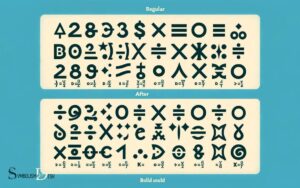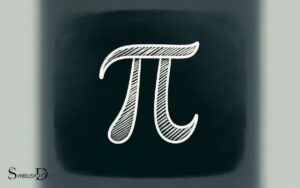Latex Math Symbols Cheat Sheet: Relations!
A LaTeX Math Symbols Cheat Sheet provides a quick reference to the multitude of mathematical symbols and notations that can be used within LaTeX documents.
This includes symbols for operations, relations, Greek letters, various arrows, and other special symbols that are commonly used in mathematical typesetting.
LaTeX is a high-quality typesetting system commonly used for scientific and mathematical documents due to its powerful handling of formulas and bibliographies.
A cheat sheet typically contains the following items:

Key Takeaway
Basic Math Operators
In LaTeX, the basic math operators can be easily typeset using a combination of backslashes and the corresponding command names.
Addition (+), subtraction (-), multiplication (imes or ), division (), and exponentiation (^{} or extasciicircum) are fundamental operators frequently used in mathematical expressions. These operators can be applied to numbers, variables, or more complex mathematical entities.
For example, to represent the equation “5 multiplied by x minus 3,” one would write “5 imes x – 3” in LaTeX. Understanding how to effectively utilize these basic math operators is essential for accurately conveying mathematical concepts in LaTeX documents.
By mastering the syntax for these operators, individuals can proficiently express a wide range of mathematical relationships and computations within their LaTeX documents.
Greek Letters
Greek letters play a crucial role in mathematical notation and are frequently used to represent various mathematical entities and concepts. They are commonly utilized in fields such as physics, engineering, and statistics.
Here are some commonly used Greek letters in mathematics:
- Alpha (α): Often used to represent angles or coefficients in mathematical equations.
- Beta (β): Frequently used to denote angles or constants in scientific formulas.
- Gamma (γ): Commonly employed to represent various concepts such as the gamma function or angles in geometry.
- Delta (δ): Widely used to symbolize a change or difference in mathematical equations, as well as in calculus and science.
Understanding and recognizing these Greek letters is essential for effectively interpreting and communicating mathematical expressions and equations.
Arrows and Delimiters
The use of arrows and delimiters is essential for accurately representing mathematical relationships and logical operations in LaTeX. When using LaTeX to express mathematical expressions, it’s crucial to understand how to utilize arrows and delimiters effectively.
Here are some key points to consider:
- Arrows: Use “” for a left arrow, “” for a right arrow, “” for a double-headed arrow, and “” for an implication arrow.
- Brackets and Parentheses: Employ “(” and “)” for inline parentheses, “[” and “]” for displayed equations, “{” and “}” for set delimiters, and “” and “” for angle brackets.
- Vertical Bars: Utilize “” and “” for absolute value bars, and “” and “” for double vertical bars.
- Custom Delimiters: You can also define custom delimiters using “” and “” to adjust the size dynamically based on the content within them.
Geometry and Algebra
Incorporating geometric shapes and algebraic equations within LaTeX facilitates the precise representation of mathematical concepts, extending the discussion on mathematical symbols further.
Geometric shapes can be accurately depicted using LaTeX commands, such as riangle for a triangle, for a square, and for a circle. These symbols are essential for effectively illustrating geometric theorems and proofs in documents.
Additionally, LaTeX’s ability to handle algebraic equations seamlessly is crucial for expressing complex mathematical relationships. Utilizing symbols like for summation, for integration, and rac for fractions allows for the clear and structured presentation of algebraic expressions.
By leveraging these capabilities, LaTeX becomes a powerful tool for seamlessly integrating geometric and algebraic elements into mathematical documents.
Calculus Symbols
Let’s now shift our focus to the fundamental calculus symbols and notations. Understanding these key calculus notations and symbolic differentiation rules is essential for mastering the principles of calculus.
Through a clear and concise examination of these points, we can gain a deeper understanding of the foundational concepts in calculus.
Key Calculus Notations
When studying calculus, it is essential to understand the key notations and symbols used in the field. These notations help in comprehending and solving complex problems.
Here are some key calculus notations:
- Derivative Notation: The derivative of a function f(x) is denoted as f’(x) or df/dx.
- Integral Notation: The integral of a function f(x) with respect to x is denoted as ∫f(x) dx.
- Limit Notation: The limit of a function f(x) as x approaches a constant value c is denoted as lim(x→c) f(x).
- Summation Notation: The sum of a sequence of terms, from k = 1 to n, is denoted as ∑(from k=1 to n) a_k.
Understanding these symbols is crucial for mastering calculus. Now, let’s delve into the subsequent section about ‘symbolic differentiation rules’.
Symbolic Differentiation Rules
Symbolic differentiation rules in calculus encompass the application of mathematical symbols to express the derivative of a function with precision and clarity.
These rules provide a systematic way to find the derivative of various functions, enabling the understanding of how a function’s rate of change varies with respect to its variables.
The power rule, product rule, quotient rule, and chain rule are fundamental symbolic differentiation rules used to differentiate a wide range of functions. The power rule is applied when finding the derivative of functions in the form of x^n, where n is a constant.
The product rule is utilized for finding the derivative of the product of two functions, while the quotient rule is employed for finding the derivative of the quotient of two functions. The chain rule is essential for finding the derivative of composite functions.
Understanding and applying these symbolic differentiation rules are essential in solving complex problems in calculus.
Miscellaneous Symbols
The category of Miscellaneous Symbols encompasses a wide range of mathematical notations and characters. These symbols play a crucial role in various mathematical expressions and equations.
Understanding the usage and representation of these symbols is essential for effectively communicating mathematical concepts and computations.
Greek Letter Notation
An important aspect of mathematical notation in LaTeX involves the use of various Greek letters as symbols for representing mathematical entities and concepts. Greek letters play a significant role in mathematical expressions, equations, and formulas.
Here are some commonly used Greek letters in mathematics:
- α (Alpha) – Often used to denote angles or as a variable in algebraic expressions.
- β (Beta) – Commonly used to represent the second angle or a variable in mathematics and physics.
- Σ (Sigma) – Represents summation in mathematics, often used to denote the sum of a series.
- ω (Omega) – Used to signify the last element in a set or the end of a sequence in mathematics and physics.
Understanding the use of these Greek letters is essential for comprehending and writing mathematical expressions effectively.
Special Characters Usage
Exploring the use of miscellaneous symbols in LaTeX mathematics notation provides a comprehensive understanding of their application in mathematical expressions. Additionally, delving into the various symbols used in LaTeX can help explore math symbol relationships and how they interact with each other within equations and formulas. Understanding these relationships can aid in creating more complex and intricate mathematical expressions, leading to a deeper comprehension of mathematical concepts and their applications in various fields such as physics, engineering, and computer science. By studying the use of miscellaneous symbols in LaTeX, one can gain a deeper appreciation for the elegance and precision of mathematical notation.
These symbols encompass a wide range of special characters, including logical operators (∀, ∃), arrows (→, ↔), and various other mathematical symbols such as ∞, ∑, and ≈.
The versatility of these symbols allows for the representation of complex mathematical concepts, making them essential in LaTeX typesetting.
When incorporating these symbols into mathematical expressions, it’s crucial to ensure proper syntax and placement to maintain the integrity and clarity of the notation.
Familiarizing oneself with the usage of miscellaneous symbols equips mathematicians, scientists, and researchers with the tools to effectively communicate and express intricate mathematical ideas within LaTeX documents.
Mathematical Operators Reference
Delving into the realm of mathematical operators within LaTeX notation, we encounter a diverse array of miscellaneous symbols that play pivotal roles in conveying intricate mathematical concepts.
Markdown Format Numeric List:
- Bbla – Represents the del operator, often used in vector calculus to denote the gradient, divergence, and curl of a vector field.
- Denotes a partial derivative in mathematics, commonly used in equations involving multiple variables.
- Symbolizes infinity, frequently utilized in limits, sequences, and series to represent unbounded values.
- Indicates the universal quantifier, signifying “for all” in mathematical logic and set theory, typically used in statements of theorems and axioms.
These miscellaneous symbols are indispensable in expressing a wide range of mathematical operations and concepts within LaTeX notation.
For All Math Symbol Latex
Here’s a list of commonly used mathematical symbols in LaTeX:
- Addition: (+)
- Subtraction: (-)
- Multiplication: (\times) or (\cdot)
- Division: (\div) or (/)
- Equality: (=)
- Greater than: (>)
- Less than: (<)
- Greater than or equal to: (\geq)
- Less than or equal to: (\leq)
- Approximation: (\approx)
- Proportional to: (\propto)
- Not equal to: (\neq)
- Subset: (\subset)
- Superset: (\supset)
- Intersection: (\cap)
- Union: (\cup)
- Element of: (\in)
- Not an element of: (\notin)
- Infinity: (\infty)
- Integral: (\int)
- Partial derivative: (\partial)
- Summation: (\sum)
- Product: (\prod)
- Square root: (\sqrt{})
- Exponentiation: (^\text{base}_{\text{exponent}})
- Absolute value: (\lvert \cdot \rvert) or (\lVert \cdot \rVert) (for norms)
- Factorial: (n!)
- Logical AND: (\land)
- Logical OR: (\lor)
- Logical NOT: (\lnot)
- For all: (\forall)
- There exists: (\exists)
- Therefore: (\therefore)
- Because: (\because)
- Arrow: (\rightarrow), (\leftarrow), (\Rightarrow), (\Leftarrow), (\leftrightarrow), (\Leftrightarrow)
You can use these symbols within math environments in LaTeX documents to express various mathematical concepts.
Conclusion
Mastering the use of LaTeX math symbols opens up a world of possibilities for expressing complex mathematical concepts in a clear and concise manner.
By understanding and utilizing the various symbols for basic math operations, Greek letters, relations, logic, arrows, delimiters, geometry, algebra, calculus, and miscellaneous symbols, one can effectively communicate mathematical ideas with precision and elegance.
Embracing the power of symbolism in mathematical writing allows for greater clarity and understanding in academic discourse.






